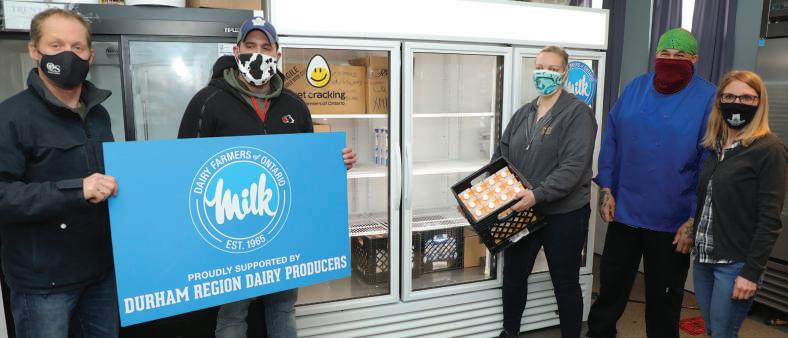DAIRY NEWS
APPLICATIONS ACCEPTED FOR ALBERTA MILK’S NEW ENTRANT ASSISTANCE PROGRAM
A
FROM LEFT are Barbara Paquet, Lactanet Canada’s board chair, and Neil Petreny, Lactanet’s chief executive officer.
LACTANET LEADERS SHARE ORGANIZATIONAL UPDATE AT AGM
W
orking together and adapting to change will be an important part of a successful future, says Barbara Paquet, Lactanet Canada’s board chair. The organization recently held its virtual annual general meeting (AGM) on Jan. 13, 2021, to share industry updates, reflect on the past year and look ahead to 2021. “We have demonstrated by working together, we can overcome all of the issues the industry could imagine as possible roadblocks to partnerships, including language, culture, traditions, regionality and control,” Paquet says about the past year. Lactanet was formed in 2019 as a partnership between the Canadian Dairy Network, Valacta and CanWest DHI to create an integrated suite of dairy services. “This year’s AGM marks not only the completion of the organization’s first full year as Lactanet, but 2021 also celebrates the 40th anniversary of Ontario DHI,” Paquet says. During the meeting, Paquet highlighted three initiatives currently underway, including a new national resolutions process, a collaborative animal improvement initiative and the addition of a second external Lactanet director for enhanced board governance. “I am proud of what we have accomplished in our first 19 months together and look forward to creating a broader vision of our future together with industry partners,” she says, who thanked dairy producers for their support and patience as Lactanet modifies protocols during COVID-19. Neil Petreny, Lactanet’s chief executive officer, highlighted accomplishments for the organization during 2020, such as the launch of eDHI, a bulk 12
FEBRUARY 2021 | MILKPRODUCER
tank fatty acid profile service in Quebec and the introduction of a new selective dry cow therapy tool to support the reduced use of antibiotics. Other significant achievements include the official launch of DairyTrace, as well as a record for DairyComp, which reached 50 per cent of DHI cows in Ontario and Western Canada that are now managed by this on-farm herd management software. Looking ahead, Petreny says a new partnership known as the International Dairy Data Exchange Network (iDDEN) was also formalized with six international milk recording partners. The goal of this collaboration is to develop and standardize a more efficient data exchange process with equipment manufacturers. Petreny also announced the release of the new feed efficiency evaluation with the April proof run. “While this genetic trait will be available for all sires as usual, results will only be provided for female animals to herds using milk recording services,” Petreny says. “Herds not using milk recording services will have to wait until December 2021 to access female evaluation results—and there will be a fee attached.” This new approach is intended to recognize the contribution of individuals who participate in industry programs and introduce a fee-for-service to those who do not—an issue that has been discussed in the industry for many years. “I would like to emphasize that Lactanet is more than milk recording,” he says. “Our partnership means we are now involved in a wider range of dairy herd management activities, including genetics, expanded lab services, advisory services and educational programs. You will see more of this in the year to come.”
lberta Milk is now accepting applications for its New Entrant Assistance Program (NEAP), which helps qualified new farmers enter the dairy industry in Alberta by offering a quota loan at no cost. “The New Entrant Assistance Program is a way for our industry to try to support those coming into the dairy industry in Alberta,” says Stuart Boeve, chair of Alberta Milk’s board of directors. “We continually review the program to make improvements to ensure we can continue to meet the needs of new dairy farms. We’re proud that 22 new farms have entered the industry through this program.” The program works by matching two kilograms of quota from Alberta Milk for every kilogram of quota purchased by the new entrant, up to 25 kg per day at no cost. This loan translates to enough quota to milk about 20 to 25 additional cows. While using the program, new entrants can expand up to 100 kg per day of total quota holdings, or about 80 to 100 cows. The loaned quota usage gradually expires beginning in the 11th year and reduces to zero at the end of year 19, marking the end of participation in the NEAP for the new entrant. Applications will be accepted until March 31, 2021. The process to qualify for the program consists of submitting an application that includes a two-year financial business plan, a 10-year implementation plan, a risk mitigation plan and a signed conditional letter of approval from the applicant’s financial institution agreeing to finance their operation. This year, Alberta Milk’s board of directors sought direction on how to improve the sustainability of the program. All accepted new entrants will now be allowed to use the NEAP loaned quota as equity or security with financial institutions. For more information on the program, visit albertamilk.com or call 1-877-361-1231. In addition to NEAP, Alberta Milk is also continuing to accept applications for its Organic Entrants Assistance Program (OEAP). Similar to the NEAP, the program is designed to encourage growth in organic dairy production in Alberta but has different guidelines. To review the OEAP requirements, visit albertamilk.com. WWW.MILKPRODUCER.CA




